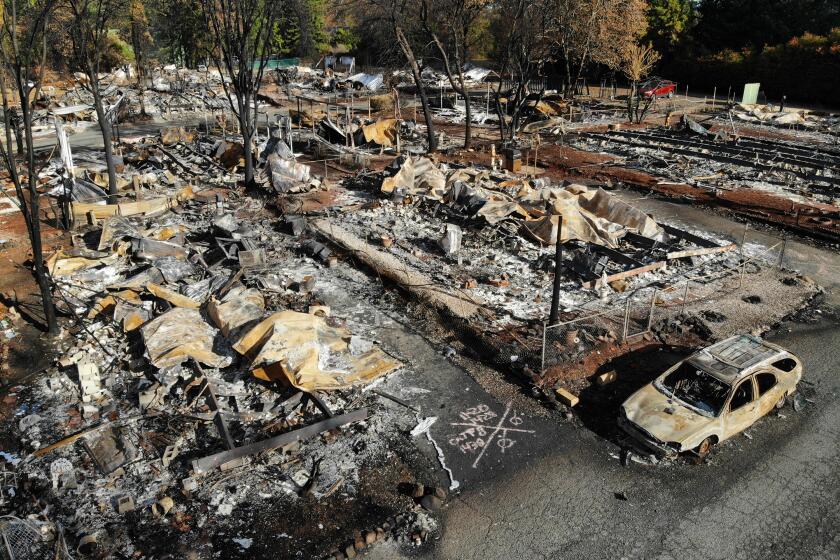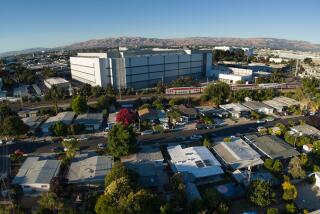Fires are coming. But PG&E and some cities are holding up battery backups
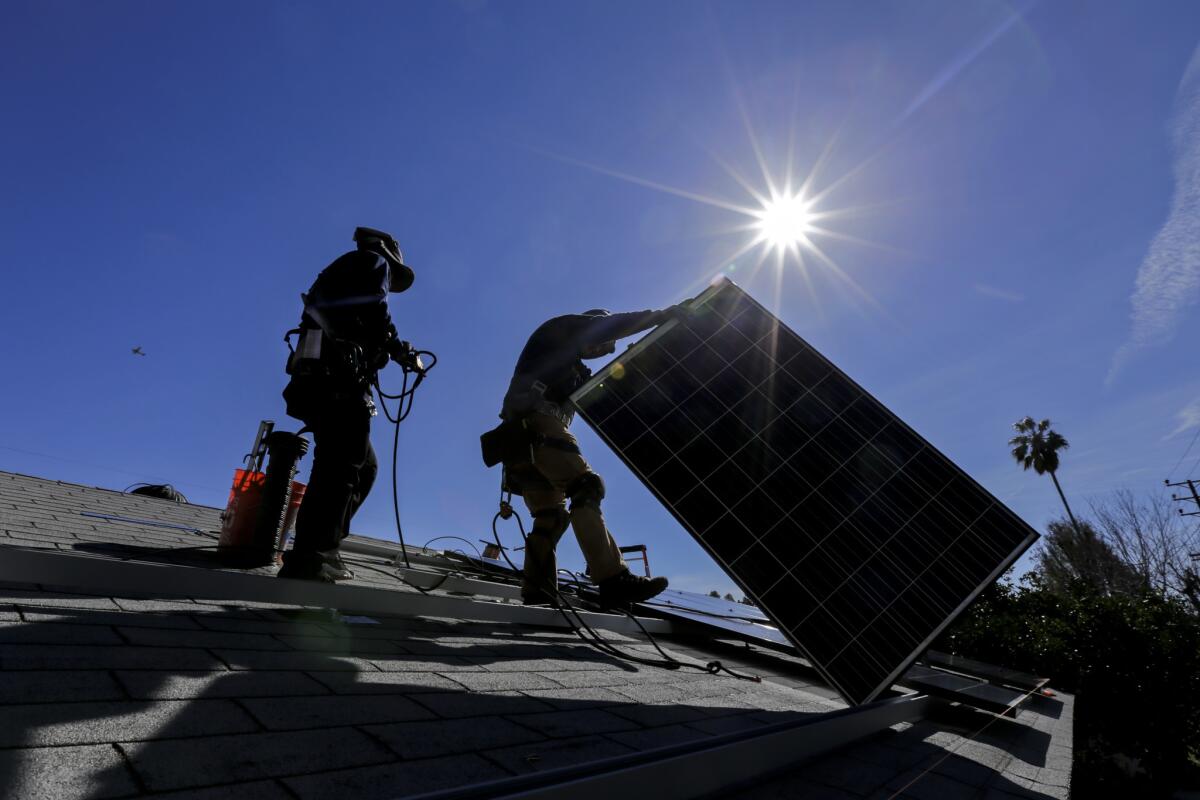
- Share via
It’s been six months since Dan Terre, his wife and their two children were forced to flee their home in Sebastopol, a small city near the coast in Sonoma County wine country, as the Kincade fire threatened to burn through town.
Sebastopol was ultimately spared. But even if Terre’s family could have stayed, they would have been stuck without electricity for five days, the result of Pacific Gas & Electric shutting down its power lines to prevent them from sparking additional blazes — a fire-prevention tool made necessary in part by the company’s long history of not adequately maintaining its infrastructure.
This year, Terre wanted to be ready with a solution: solar panels on his roof and a big battery in his garage to keep power flowing to his family’s lights, refrigerator and pollution-filtering air conditioner the next time PG&E decided to shut off the electricity.
But as the coronavirus brought much of daily life to a halt, problems mounted for Terre’s solar-plus-storage project. Sebastopol had closed its permit office. And PG&E had stopped doing the on-site work that many home solar installations need to move forward.
“I don’t know how much lower I could think of PG&E at this point. But they’re not even providing the basic services for us to be able to protect ourselves from their negligence,” Terre said.
With California’s next fire season just a few months away, companies are scrambling to install rooftop solar panels and electricity-storing batteries at customers’ homes to help them keep their food cold and their phones charged during the power shutoffs to come.
But with most economic activity shut down due to the COVID-19 pandemic, solar firms say they’re stuck navigating confusing local rules that have made it difficult to do business in parts of the state, especially the San Francisco Bay Area. Some solar workers have been ordered down from rooftops after neighbors called the police, even in places that have nominally allowed solar and battery projects to continue, according to Bernadette Del Chiaro, executive director of the California Solar and Storage Assn., an industry trade group.
Uneven enforcement of unclear local stay-at-home orders is just one problem facing installers, Del Chiaro said. Another issue is that some cities and counties have shut down their building permit offices, or are refusing to issue permits for solar and storage projects.
“We could ask every single building department in the state, and there are over 500,” Del Chiaro said. “And they would all have a different answer” about their ability to issue permits.
Your guide to our clean energy future
Get our Boiling Point newsletter for the latest on the power sector, water wars and more — and what they mean for California.
You may occasionally receive promotional content from the Los Angeles Times.
Then there’s PG&E, the San Francisco-based utility company that filed for bankruptcy protection last year in the face of tens of billions of dollars of potential liabilities from fires ignited by its infrastructure, including the Camp fire, which killed 85 people.
Under pressure from the solar industry, PG&E ultimately changed course on rooftop projects, announcing that beginning May 1, it would start disconnecting and reconnecting customers like Terre who want to add solar or batteries to their homes.
“We want to make sure that obviously we move cautiously, and continue to keep our customers protected, and make sure that our field workers are protected in doing that,” Maril Wright, senior director of PG&E’s energy savings assistance program, said during a Public Utilities Commission workshop last week.
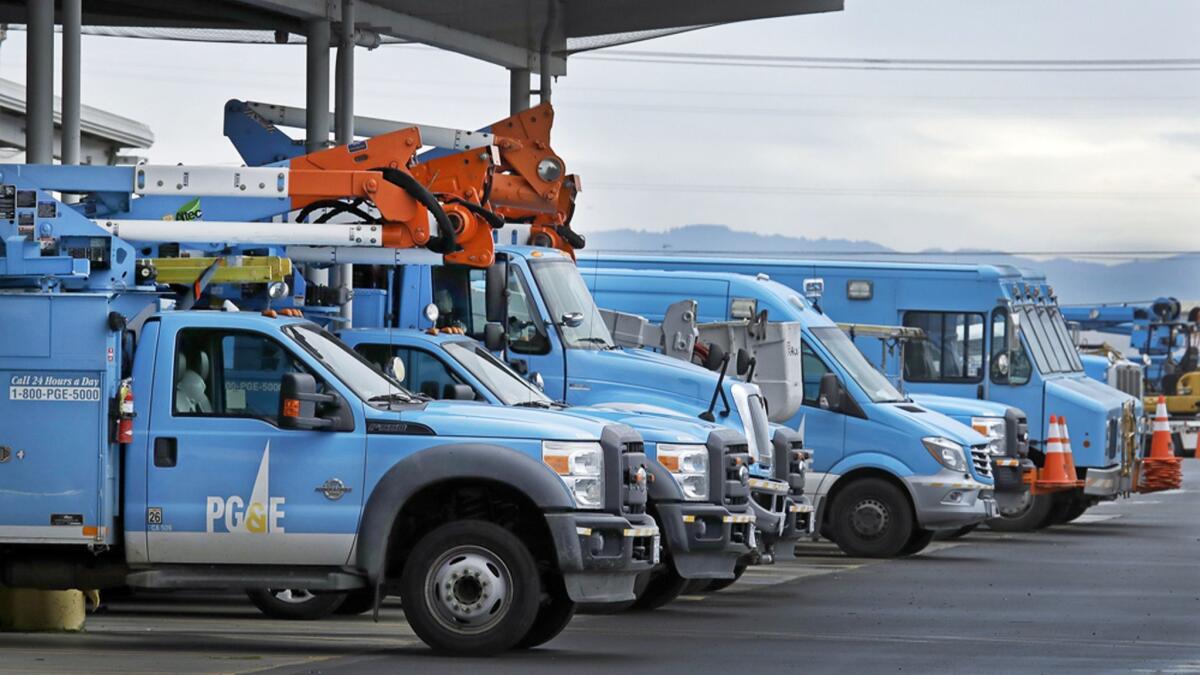
For the solar industry, local governments might be a harder nut to crack.
Gov. Gavin Newsom’s office issued a directive last month that included the electricity sector on a list of industries exempt from stay-at-home orders, but it didn’t mention solar projects explicitly. The California Energy Commission got more specific on Monday, releasing a statement clarifying that solar and energy storage installers are considered essential electricity industry workers.
The Energy Commission “supports local enforcement agencies continuing to permit building construction and energy projects, including [solar] and battery storage installations for both newly constructed and existing buildings,” the commission said.
It’s yet to be seen if cities and counties might respond by making life easier for solar and battery installers.
In the meantime, companies continue to grate against local rules they feel are unnecessary and counterproductive.
Take Santa Clara County in the Bay Area, an early hot spot for coronavirus infections. County officials initially allowed installations only of solar-plus-storage systems, since those systems can provide backup power. Adding solar panels without batteries “should be postponed if the system would not provide backup power in the event of an outage,” the county said on its website.
The county changed its policy this week, issuing a new shelter-in-place order, effective May 4, that allows all rooftop solar projects to proceed.
But to solar providers, the county’s original policy missed a key point: that rooftop panels can help people keep their energy costs down at a time when millions of Californians have filed for unemployment and residential electricity use is up as much as 20%. Some solar installers offer no-money-down deals that allow homes to start reducing their monthly electricity costs immediately.
“We have been asking [Santa Clara County] to clarify that solar is essential, and explaining to them how we’re very much a part of the electricity sector,” said Anne Hoskins, chief policy officer at San Francisco-based Sunrun Inc., the largest U.S. rooftop solar installer.
“Small-scale solar counts as essential, as does Diablo Canyon nuclear power plant,” she added. “The state does not differentiate.”
Your support helps us deliver the news that matters most. Subscribe to the Los Angeles Times.
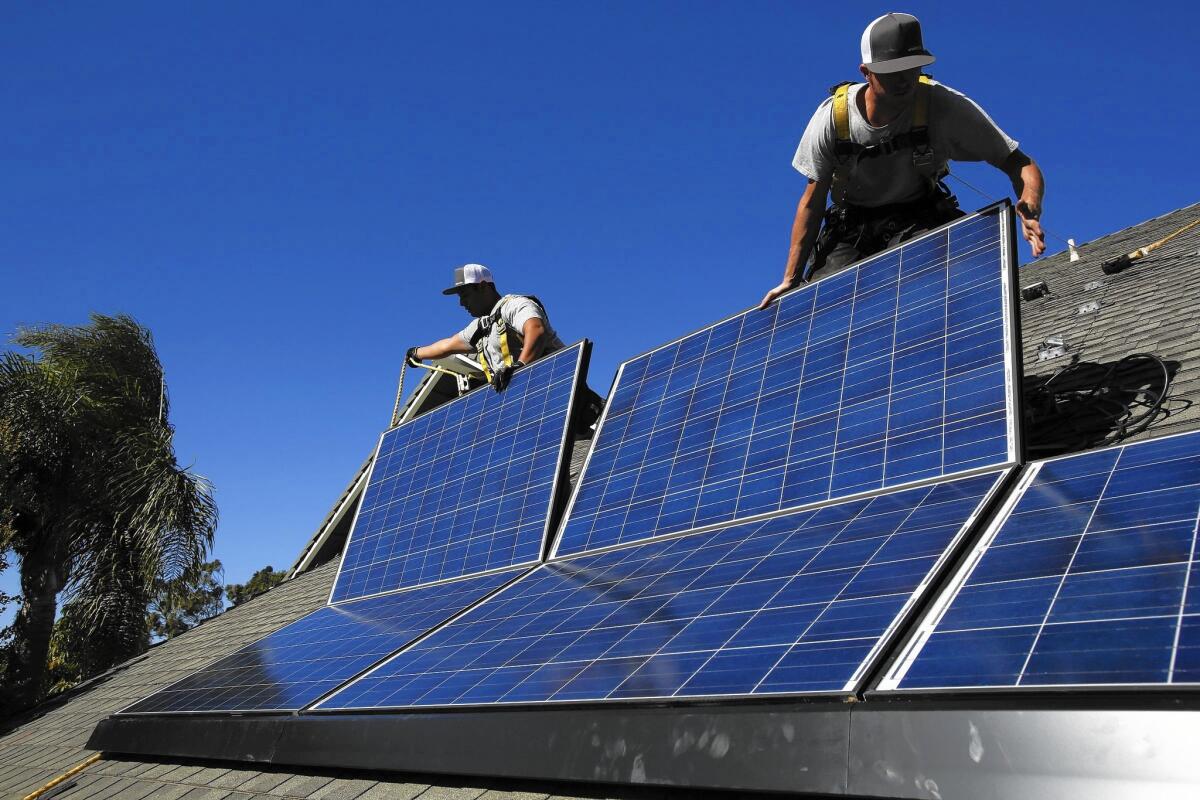
Although some economists dismiss rooftop solar as an expensive sideshow to big, centralized solar farms that generate electricity more cheaply, it has grown rapidly in California in recent years, in part because of the cost savings it offers to consumers.
Federal data show that electricity generation from solar installations smaller than 1 megawatt — which mostly consist of rooftop panels on single-family homes, commercial businesses and other buildings — more than tripled in California between 2014 and 2019. The state got more electricity from small solar projects last year than it did from wind turbines.
California also hit its longtime goal of 1 million solar roofs last year.
And there are growing signs that small-scale solar could play an important role in the future of the power grid.
East Bay Community Energy, a government-run electricity provider in Alameda County, signed a contract last year with Sunrun for half a megawatt of “resource adequacy” — an important energy service that has long been the domain of large power plants.
Just last week, Public Utilities Commission staff proposed that utilities evaluating how much value they would get from small solar installations must consider the cost savings from not having to build new transmission lines to import power from faraway solar farms. It’s a change that would help fuel the construction of local solar facilities that can help communities keep the lights on when long-distance lines are shut down to prevent fires, said Craig Lewis, executive director of the nonprofit Clean Coalition.
“Not only do you get cheaper energy, but you get the resilience benefit for free,” Lewis said.
Like most of the rest of the economy, the solar industry has been hurting over the last two months.
The California Solar and Storage Assn. surveyed more than 200 of its member companies this month and concluded that 15,000 people have likely been laid off or furloughed, about 20% of the sector’s overall workforce in the state. Smaller companies reported laying off a higher percentage of their employees. More than 90% of solar installers surveyed said business is down.
The novel coronavirus has hit one of America’s fastest-growing employment sectors especially hard.
Brad Heavner, the trade group’s policy director, described a problem where solar and storage companies can’t develop a project pipeline without employees, but can’t pay employees unless they have projects in the pipeline.
“The longer this happens, the harder it will be to crawl out,” Heavner said during a Public Utilities Commission workshop.
It’s not possible for solar installation crews to maintain six feet of distance, the public health guideline for avoiding transmission of the novel coronavirus, at all times. Carrying a heavy lithium-ion battery into a garage, for instance, may require two people.
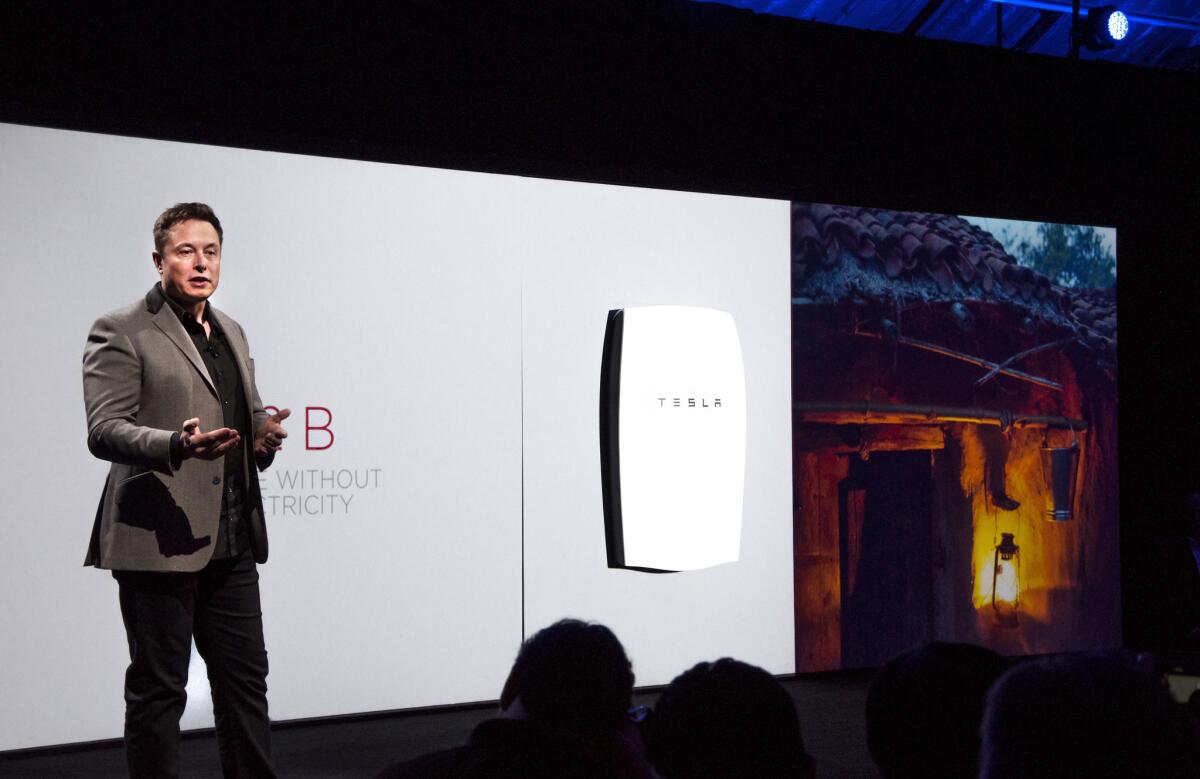
But solar firms say they are minimizing risk to their customers and employees.
More than two dozen companies sent a letter to Santa Clara County outlining the steps they have taken to abide by public health guidances, including conducting sales calls online and aiming for “zero physical contact with customers” during installation.
Nate Otto, president of Hot Purple Energy in Palm Springs, said he’s limited crew sizes and instructed workers to drive to job sites separately. He said his employees have been wearing masks and gloves since before it was required by Riverside County.
For weeks, Palm Springs refused to issue permits for Hot Purple Energy to install solar and storage projects. But the city changed course this week, Otto said, after he convinced officials that building inspectors could do their work without going into homes.
“Now they’ll issue the permits, but it’s still going to be slow,” Otto said. “Just because of all the difficulties of COVID.”
Unlike some of his industry peers, Jeff Mathias, co-owner and chief financial officer of Synergy Solar in Sonoma County, thinks solar-only installations are nonessential and ought to stop for now. But he sees solar-plus-battery systems as a critical backup power source for people worried about sheltering in place during the preemptive power outages that are likely to come this fall.
Mathias has been frustrated by a rapidly shifting landscape of city and county rules defining “essential work.” He also pointed to a Santa Rosa retirement community where, he said, the architectural committee has stopped approving any new solar system designs. It’s the type of place where some older residents may depend on electricity to power life-sustaining medical equipment.
“We have to get these jobs done before September, and every day we can’t work is one more job we can’t install,” Mathias said.
Like Pacific Gas & Electric, the state’s other big investor-owned utilities — Southern California Edison and Sempra Energy subsidiary San Diego Gas & Electric — both shut off electricity to some customers at times last year in an effort to avert fire ignitions.
But those outages were more limited. And Edison and SDG&E have continued to disconnect and reconnect solar customers as needed.
PG&E said it reached a settlement with the Butte County district attorney’s office on March 17. The utility’s critics say the plea deal is too lenient.
It’s typically been easier to get solar and batteries installed in Southern California during the coronavirus outbreak, companies say.
The California Solar and Storage Assn. pointed to Los Angeles County as one of a few jurisdictions that adopted virtual inspections well before COVID-19. The cities of Irvine in Orange County and Oceanside in San Diego County have followed suit since the pandemic began. The trade group also lauded the city of Los Angeles and San Diego County for offering online permitting with quick turnarounds.
The energy storage business could get a boost on May 1, when the Public Utilities Commission starts accepting applications for more than $600 million in incentive funding for battery installations in homes that could see their power shut off come fire season.
The funding will be available to homes in areas that are at high fire risk and whose residents are low income, depend on electricity-powered medical devices or have seen their power shut off in two previous five-prevention outages. Critical facilities in high-risk areas — including police and fire stations, hospitals, cooling centers, homeless shelters and grocery stores — can also apply for incentives.
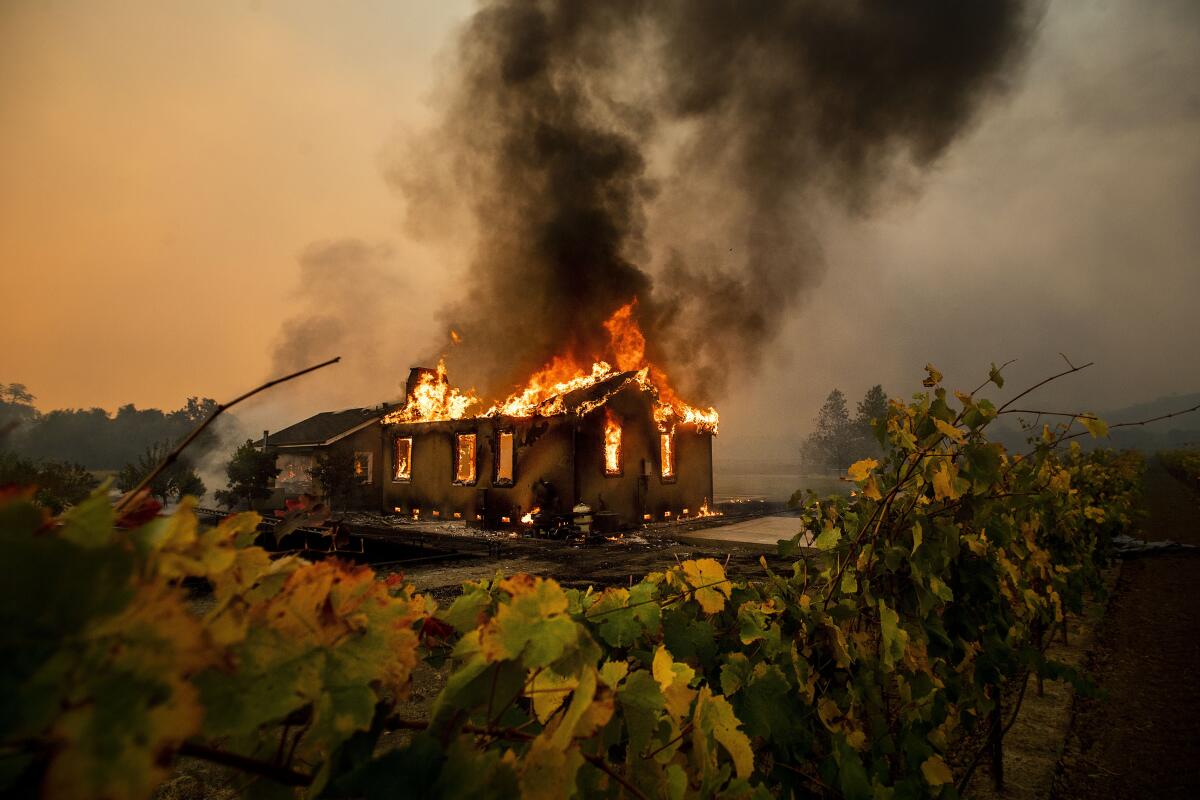
Rooftop solar advocates hope the Public Utilities Commission will get the money flowing quickly.
“This is the time for us to access that and aggressively go out and work with customers to help them be prepared,” Sunrun’s Hoskins said. “It not only provides a resilient source of energy, but it helps support these companies. This is a source of jobs.”
Terre, whose family evacuated during the Kincade fire, was able to get solar panels and a battery — but only by skirting the rules.
He had a contractor install the system this month despite not being able to get a building permit from Sebastopol. The city reopened its permit office last week and retroactively issued a permit, he said. As for PG&E, Terre said he talked with a lineman who called his employer’s work restrictions “bogus” and promised to come back next week to get everything ready to go.
Terre said he’s long wanted to go solar and get off fossil fuels. The threat of blackouts made the decision more urgent.
“I want the battery because I want the security,” he said.
